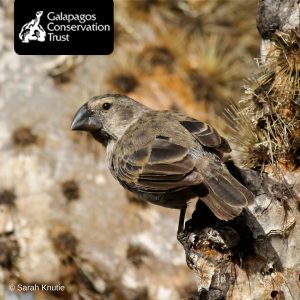For 40 years the island of Daphne Major has been a key site for evolutionary research. The island’s remote location, low levels of human activity, and small number of predators and competitor species make it the ideal site for evolutionary studies. An incredible recent study by a group of researchers on the island has now observed the formation of an entirely new species of finch over just two generations.
As referenced in our most recent blog, Daphne Major was the island where Peter and Rosemary Grant made a major breakthrough in evolutionary thinking. Here they proved that evolutionary changes in response to changing environmental conditions could happen over timescales previously thought impossible. Alongside other researchers, the couple has once again changed the way we view evolution, observing the creation of a new species in just two generations.
The newly formed ‘Big Bird’ finch species can be dated back to the chance arrival of a large, lone male cactus finch believed to have arrived from the island of Espanola 65 miles away. Much like the original species to arrive in Galapagos, the bird was probably helped to the island by strong ocean winds. During their studies of the medium ground finch population on the island, the Grants witnessed this lone male mating with a resident female, producing fertile young.

During their studies of the medium ground finch, as pictured here, the Grants noticed the lone male mating with a native female © Sarah Knutie
Previously it was thought that in order for two individual species to be classed as separate species, they must be unable to interbreed to produce fertile young. However, in recent years these lines have begun to blur with an acceptance that two distinct species can breed to produce fertile young. This study highlights the vital role that two species breeding together can play in the creation of an entirely new species.
Key to the survival of a newly formed species is being ecologically competitive, i.e. it must be well equipped to compete for other food and nesting space in its new habitat. Unlike most breeding events between two different species, where the offspring are poorly adapted to their surrounding environments, in this instance the larger body size of the aptly named ‘Big Bird’ allowed it to take advantage of previously untouched food resources.
Contrary to the researchers’ belief that the newly formed population would breed with the native finch species, ‘Big Bird’ individuals have formed a closed population, only breeding with other birds of their kind. This was due to their song differing from the native finch species, making them unable to attract mates. Additionally, beak size and shape are hugely important when finding a mate, which again differed from the local finch species.

The new population has not mated with other resident species, such as the large ground finch pictured above © Robert Stebbings
The researchers believe that if a new species can form over just two generations, then there is no reason to believe that such breeding events haven’t played a role in the formation of modern day finch species throughout the Islands. Discover more about Darwin’s theory of evolution and finch adaptations in our Evolution Zone, complete with brilliant teaching resources for your classes.
Source information:
http://www.bbc.co.uk/news/science-environment-42103058



 (No Ratings Yet)
(No Ratings Yet)